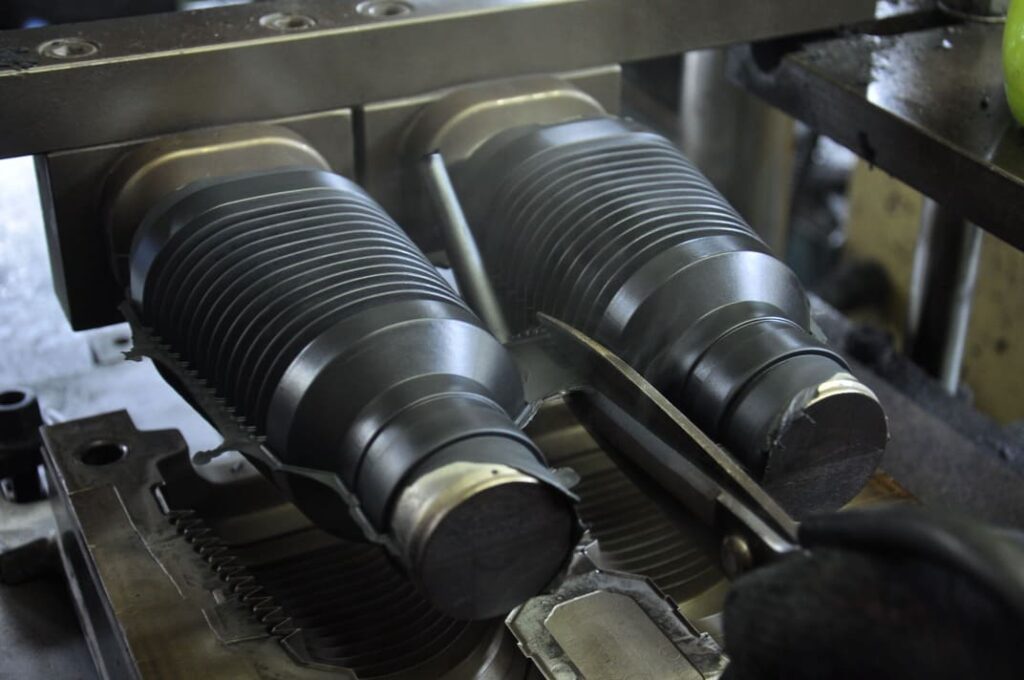Are you searching for reliable rubber bellows manufacturers? Whether for industrial, automotive, or custom applications, choosing the right manufacturer is crucial for product quality and performance.
Rubber bellows are vital components used for sealing, protecting, and compensating for movement in machinery and equipment. Finding a trustworthy manufacturer ensures high-quality, durable bellows for your specific needs.

When it comes to sourcing rubber bellows, there are key factors to consider, such as material selection, customization capabilities, and the manufacturer’s experience. Let’s explore the essential qualities to look for in a rubber bellows manufacturer and the benefits of choosing a supplier with a proven track record.
What Are Rubber Bellows?
Wondering what rubber bellows are and why they are crucial for your application? You might need a basic understanding of these components before choosing the right manufacturer.
Rubber bellows are flexible, accordion-like seals designed to protect machinery parts from dirt, moisture, and other contaminants while compensating for movement and vibrations.
Rubber bellows are used in a wide range of industries, including automotive, manufacturing, and electronics. Their primary purpose is to cover and protect moving parts like shafts, rods, or pistons, preventing contamination and damage. The accordion-like structure allows them to expand and contract while maintaining a seal.
In industrial machinery, rubber bellows1 protect parts from dirt, dust, and moisture, ensuring smooth operation and extending the lifespan of the equipment. In automotive applications, they are commonly used to shield steering or suspension components from debris while compensating for movement due to road conditions.
Materials used in rubber bellows can vary, but the most common are natural rubber, EPDM (Ethylene Propylene Diene Monomer)2, neoprene, and nitrile. Each material offers unique properties like flexibility, chemical resistance, and temperature tolerance, making them suitable for different applications.
Key Benefits of Rubber Bellows:
| Benefit | Explanation |
|---|---|
| Flexibility3 | Expands and contracts to absorb movement |
| Durability4 | Protects components from wear and tear |
| Sealing Properties5 | Prevents the entry of dirt, moisture, and contaminants |
| Temperature Resistance | Some materials resist extreme temperatures for extended periods |
✅ Why it matters:
The right rubber bellows protect critical components from external elements, improve the longevity of machinery, and reduce downtime caused by repairs.
How to Choose a Rubber Bellows Manufacturer?
Are you unsure how to select a rubber bellows manufacturer? You may want to know the key factors that ensure you partner with a capable and reliable supplier.
Choosing a reliable rubber bellows manufacturer involves assessing material options, customization capabilities, production capacity, and quality control practices.

When selecting a rubber bellows manufacturer, several factors should guide your decision:
Material Expertise6: Ensure the manufacturer has experience working with a wide range of rubber compounds. Depending on your application, you might need bellows made from EPDM, neoprene, or nitrile. The manufacturer should be able to recommend the most suitable material based on the environment and stress factors.
Customization Capabilities7: Every application is unique, and you might require custom-designed bellows to meet specific size, shape, or performance requirements. A top-tier manufacturer will offer the flexibility to create custom molds and produce bellows tailored to your needs.
Production Capacity: If you require a large quantity of rubber bellows, choose a manufacturer with the production capability to meet your deadlines and maintain consistent quality. Ask about their lead times, tooling capabilities, and ability to scale production.
Quality Control8: A reputable manufacturer will have stringent quality control processes in place. Look for manufacturers that provide detailed product testing (e.g., pressure tests, temperature resistance, and durability tests) to ensure the bellows will perform reliably in your application.
Experience and Reputation: Choose a manufacturer with a proven track record in producing rubber bellows. Check customer reviews, industry certifications (e.g., ISO standards), and their portfolio of successful projects.
| Factor | Importance |
|---|---|
| Material Expertise | Ensures the right compound for your application |
| Customization | Provides tailored solutions for your unique needs |
| Production Capacity | Ensures timely delivery for large orders |
| Quality Control | Guarantees consistent product reliability |
| Reputation & Experience | A proven track record ensures trust and dependability |
✅ Why it matters:
Choosing the right manufacturer impacts product performance, longevity, and cost-efficiency. Reliable manufacturers help avoid the risks of product failure, leading to fewer repairs and downtime.
What Is the Process of Manufacturing Rubber Bellows?
Curious about the manufacturing process behind rubber bellows? Understanding the steps involved can help you assess a manufacturer’s capabilities.
The process of manufacturing rubber bellows typically involves material selection, mold design, injection molding or compression molding, and curing.
The manufacturing process of rubber bellows involves several stages:
Material Selection9: The first step is selecting the appropriate rubber material based on the application’s requirements. Materials like EPDM, nitrile, and neoprene are chosen for their unique properties, including temperature resistance, flexibility, and chemical resistance.
Mold Design: A custom mold is created to shape the rubber bellows. The design of the mold is crucial for ensuring that the final product fits correctly in its intended application. The mold is also designed to create the accordion-like folds that allow the bellows to expand and contract.
Molding Process10: The rubber compound is placed into the mold, and the manufacturing process is typically either injection molding or compression molding. Injection molding is preferred for precision and high-volume production, while compression molding is used for larger parts and slower production cycles.
Curing: After molding, the rubber is cured in an oven to solidify the material. This curing process cross-links the polymer chains in the rubber, giving the bellows its final strength, flexibility, and durability.
Testing and Quality Control11: Once cured, the rubber bellows undergo rigorous testing to ensure they meet performance standards. This may include testing for tensile strength, temperature resistance, and dimensional accuracy.
Key Stages of Rubber Bellows Manufacturing:
| Stage | Description |
|---|---|
| Material Selection | Choosing the right rubber compound |
| Mold Design | Creating the mold for the rubber bellows shape |
| Molding | Forming the bellows using injection or compression molding |
| Curing | Heat treatment to harden and set the rubber |
| Testing | Final checks for strength, size, and durability |
✅ Why it matters:
A streamlined and precise manufacturing process ensures that rubber bellows meet the required standards for your application, minimizing the risk of defects and failure.
Why Is Injection Molding So Expensive for Rubber Bellows?
Is the high cost of injection molding for rubber bellows making you hesitant? Understanding why it’s expensive can help you make informed decisions.
Injection molding for rubber bellows can be expensive due to the high cost of precision molds, specialized equipment, and the need for skilled labor to ensure quality.
Injection molding for rubber bellows involves high upfront costs, mainly due to the creation of precision molds12. These molds need to be designed with intricate details to allow the bellows to expand and contract. The cost of the mold is typically one of the largest expenses in the manufacturing process.
Additionally, silicone or rubber compounds require specialized injection molding equipment13 to handle the unique properties of elastomers. This equipment ensures the rubber flows correctly into the mold and cures efficiently, but it comes at a significant investment.
The process also demands skilled labor14. Precision is critical when it comes to molding rubber bellows, especially in applications where exact tolerances are necessary. Skilled operators are needed to ensure that the molding machine is set up correctly and that the product meets stringent quality standards.
| Cost Factor | Explanation |
|---|---|
| Precision Molds | High tooling costs for complex shapes |
| Specialized Equipment | Need for specialized injection molding machines |
| Skilled Labor | Labor-intensive process requiring expert operators |
| Materials | High-quality rubber compounds add to the cost |
✅ Why it matters:
While the initial investment for injection molding can be high, it often pays off in high-volume production. For lower volumes, you might want to consider alternative methods like compression molding or 3D printing to lower initial costs.
Conclusion
Rubber bellows are crucial for a variety of applications, offering protection and compensation for movement in machinery. Neoprene and EPDM are the best materials for saltwater and extreme environments. When choosing a manufacturer, it’s essential to consider their material expertise, production capabilities, and quality control measures. Injection molding can be expensive due to the precision molds, specialized equipment, and skilled labor required, but the cost is often justified by the high-quality and consistent parts produced.
🚀 Need Custom Rubber Bellows for Your Industry?
Contact Julong Rubber today or Request a Custom Quote to get the perfect rubber bellows designed for your specific needs!
Explore this link to understand how rubber bellows enhance performance and longevity in different sectors. ↩
Learn about EPDM's unique properties and why it's a preferred material for rubber bellows in demanding applications. ↩
Understanding flexibility in rubber bellows can help you choose the right product for your needs, ensuring optimal performance. ↩
Exploring durability can guide you in selecting rubber bellows that last longer, saving costs on replacements and repairs. ↩
Learning about sealing properties is crucial for preventing contamination, which can enhance the efficiency of your machinery. ↩
Understanding material expertise is crucial for ensuring the right rubber compound is used for your application. Explore this link for insights. ↩
Customization can significantly impact the performance of your bellows. Discover why this factor is essential for your needs. ↩
Quality control is vital for product reliability. Learn about the necessary testing and standards to look for in a manufacturer. ↩
Understanding material selection is crucial for ensuring the quality and performance of rubber products. Explore this link for expert insights. ↩
Learn about the advantages and applications of different molding processes to optimize production efficiency and product quality. ↩
Discover essential testing methods that ensure rubber products meet industry standards and enhance reliability in applications. ↩
Understanding precision molds is crucial for grasping the complexities and costs involved in rubber bellows manufacturing. ↩
Explore how specialized equipment enhances the efficiency and quality of rubber molding processes, ensuring optimal results. ↩
Learn about the significance of skilled labor in achieving precision and quality in rubber bellows production, a key factor in manufacturing success. ↩







